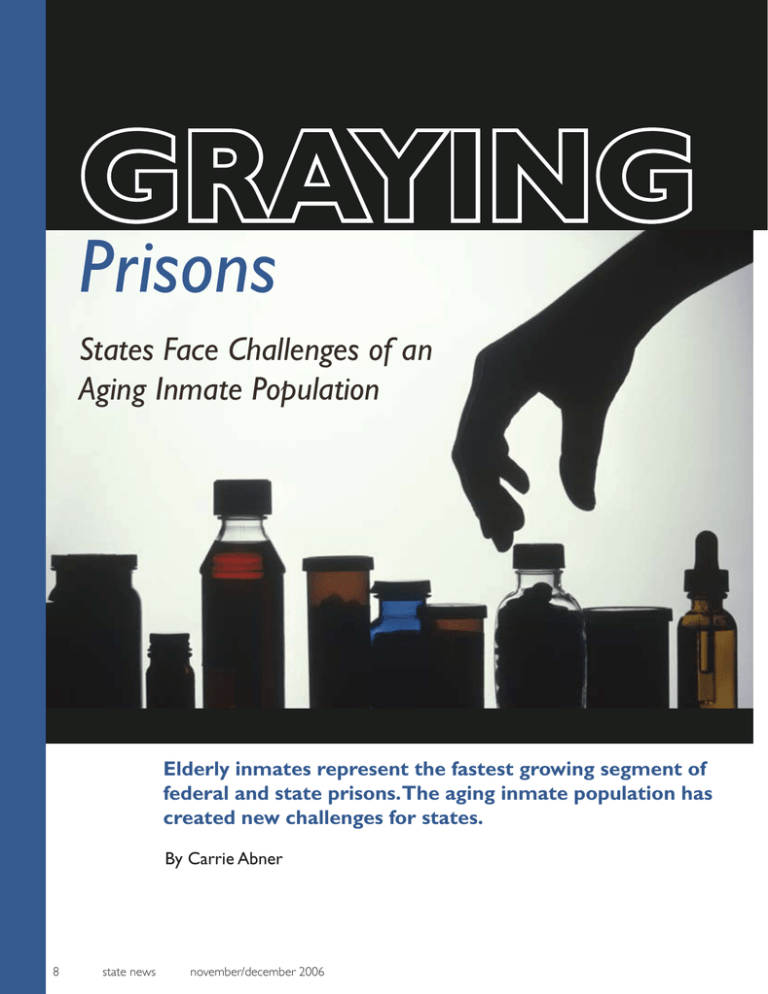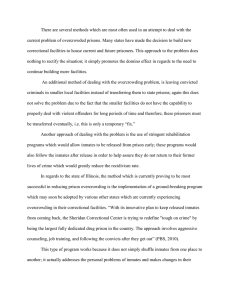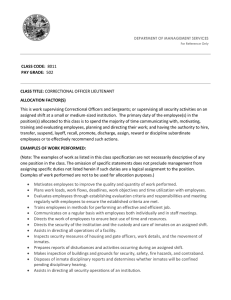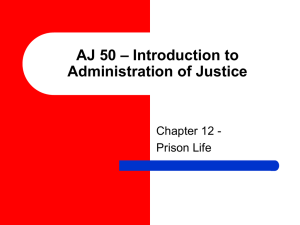GRAYING Prisons States Face Challenges of an Aging Inmate Population
advertisement

GRAYING Prisons States Face Challenges of an Aging Inmate Population Elderly inmates represent the fastest growing segment of federal and state prisons.The aging inmate population has created new challenges for states. By Carrie Abner state news november/december 2006 “ Prisons aren’t geared to the needs and vulnerabilities of older people. In the prison environment, there are a number of unique physical tasks that must be performed every day in order to retain independence. They’re not the same tasks that are called for in the community. ” —Brie Williams, M.D. Geriatrician at the San Francisco VA Medical Center At age 89, Earl takes six pills a day and carries a bottle of nitroglycerin pills with him at all times in case he has a heart attack or stroke. His fingers are shriveled with arthritis and he’s had cataract surgery three times. He just received a wheelchair to help him get around. From outside appearances, Earl may seem like most other elderly men in America with a growing list of age-related ailments. But while many of his peers reside in nursing homes and assisted living facilities, Earl will likely call Wisconsin’s Oshkosh Correctional Institution home for the rest of his life. Earl represents a growing number of elderly inmates in state prisons across the country. As this population continues to rise, states are taking note. decades are keeping more offenders in prison for longer periods of time. And inmates are living longer, meaning prisons continue to swell. Tending the Elderly Behind Bars: The Challenge for States For states, the challenges associated with an aging prisoner population are real and growing, yet statistics on the numbers of elderly inmates are difficult to project. This is due in part to variations in the definitions states have established for elderly prisoners. For instance, while Ohio defines elderly inmates as those aged 50 and older, Minnesota sets the age at 55. Michigan considers those 60 and above as elderly, while in Colorado, this designation is reserved for inmates 65 and older. Other states have no official age designation for the elderly prisoner population. What’s more, inmates tend to age faster than members of the general population. Research indicates that a prisoner’s physiological age is, on average, seven to 10 years older than their chronological age. Therefore, a 50-year old inmate may likely experience the age-related health problems of a 60-year old on the outside. Dr. David Thomas, who chairs the Department of Surgery at Nova Southeastern University and previously directed the Florida Department of Corrections’ Office of Health Services, recalls one of his first encounters with older inmates. Having met a prisoner he thought to be 70 to 75 years old, he was surprised to learn that the inmate was just 54. “Inmates appeared to be physically and medically older than their actual age,” he said. Thomas and others point to a number of factors contributing to this phenomenon, including lack of access to health care services prior to entry, poor dietary and exercise habits, and substance abuse. A 2000 study by the Florida Department of Corrections’ Office of Health Services found that almost two-thirds of inmates received their first significant health care experience, defined as any surgery or filled and started prescription, while in prison. Stress also contributes to accelerated aging among inmates. “The stress of incarceration—including lack of support systems and a lack of trust in fellow inmates—leads to chronically stressful and debilitating environments,” said Thomas. As a result, older inmates tend to develop age-related health Elderly Inmates: A Growing Trend According to the U.S. Justice Department’s Bureau of Justice Statistics, the U.S. prison population has grown from just over 319,000 in 1980 to nearly 1.5 million in 2005. Elderly inmates represent the fastest growing segment of federal and state prisons. A 2004 report by the National Institute of Corrections states that the number of state and federal prisoners ages 50 and older rose 172.6 percent between 1992 and 2001, from nearly 42,000 to more than 113,000. Some estimates suggest that the elder prisoner population has grown by as much as 750 percent in the last two decades. Experts say the growth of the elder inmate population is expected to continue. According to Jonathan Turley, a law professor at George Washington University and director of the Project for Older Prisoners, the population of prisoners ages 50 and older in the federal system grew from 11.3 percent of the total prison population in 1986 to 26 percent in 1989. He adds that even conservative estimates suggest that this population will represent 33 percent by 2010. Why such a dramatic increase in the older prisoner population? Experts point to a number of reasons. First, the rise in older prisoners reflects the general aging of society. In 2003, there were an estimated 36 million individuals age 65 or older in the United States, comprising just over 12 percent of the total population. According to the Federal Interagency Forum on Aging-Related Statistics, the older population grew from 3 million to 35 million in the 20th century. Officials also point to the get-tough-on-crime reforms of the 1980s and 1990s as contributing factors to the growing numbers of older prisoners. Mandatory minimum sentences, threestrikes rules and truth-in-sentencing laws established in recent the council of state governments www.csg.org State and Federal Inmates Age 50+ (1992 – 2001) Year Inmates Year Inmates 1992 41,586 1997 73,543 1993 44,302 1998 83,667 1994 50,478 1999 92,362 1995 55,281 2000 103,132 1996 63,004 2001 113,358 Source of Statistics: Anno, B. Jaye, Camilia Graham, James E. Lawrence, and Ronald Shansky. Correctional Health Care: Addressing the Needs of Elderly, Chronically Ill and Terminally Ill Inmates. U.S. Department of Justice/National Institute of Justice. 2004. problems earlier. According to Turley, an elderly inmate will experience an average of three chronic illnesses during his or her term. The National Institute of Corrections lists arthritis, hypertension, ulcer disease, prostate problems and myocardial infarction among the most common chronic diseases among elderly inmates. Diabetes, Hepatitis C and cancer are also common. The financial burden for states in providing adequate health care for older prisoners is staggering. In 1997, the Texas Criminal Justice Policy Council reported that health care for elderly inmates ran $14.80 per day, nearly three times the health care costs for younger prisoners. While a younger prisoner costs approximately $22,000 to house annually, states pay an average of $67,000 per year for older inmates. And as the aging prisoner population grows, the costs for states are expected to rise. Experts estimated that annual costs for providing health care to elderly inmates in Texas could increase from $27 million in 1999 to $56 million in 2008. In addition to the rising health care costs, the aging prisoner population presents additional challenges for the states, including general accommodations and protection against younger offenders. Like the elderly population outside prison walls, older inmates need special adaptive devices to help overcome physical impairments. For many elderly, walkers, canes, hearing aids, eyeglasses, dentures and geriatric chairs are necessary to function well. Beyond meeting the general needs of an aging population, however, states must also address the specific needs of the aging population in prison settings. One of the primary challenges for states is adapting prison facilities that originally were not designed with elderly residents in mind. “Prisons aren’t geared to the needs and vulnerabilities of older people,” said Brie Williams, MD, a geriatrician at the San Francisco VA Medical Center and lead author of a recent study on aging female prisoners. “In the prison environment, there are a number of unique physical tasks that must be performed every day in order to retain independence. They’re not the same tasks that are called for in the community.” 10 state news november/december 2006 The study of 120 elderly female prisoners in California found that 69 percent reported that at least one activity of daily living was very difficult to perform. Sixteen percent reported that they needed assistance with at least one daily activity, representing twice the rate of the general U.S. population 65 or older. In many cases, inmates rely on younger prisoners to get around. For some elderly prisoners, however, the general prison population can be threatening. The NIC cites vulnerability of abuse and predation and difficulty in establishing social relationships with younger inmates as some of the specific challenges associated with an aging prisoner population. According to a 2004 NIC report, “the lack of personal protection for elderly inmates, who may be frail and therefore vulnerable to the threats of assault by younger predatory inmates, contributes to the emotional stress and physical deterioration they routinely experience, especially among those who may be already vulnerable owing to chronic or terminal illness and who have few options for change in their environment.” States React: Programs and Policies for an Aging Prison Population Across the country, states are beginning to take steps to address the implications of an older prison population. From developing targeted programs and activities for elderly inmates to providing specialized geriatric care, state corrections departments are devoting an increasing amount of attention and resources to the needs of seniors. In a 2001 survey by the Criminal Justice Institute, approximately 15 of the 44 participating states and territories indicated that they provided supervised recreational programs specifically designed for older and elderly inmates. And other states have established educational programs on wellness and aging issues as part of an overall preventive care program. Ohio’s Hocking Correctional Facility offers a “50+ and Aging” program, which is designed to address the physical, psychological and social needs of older inmates. Such activities as chair aerobics, adult basic education and GED classes are provided as part of the program, as well as specialized recreational options, including bingo, shuffleboard, horseshoes and a walking program. Case managers also provide assistance to elderly inmates applying for Social Security and Medicare benefits. Pennsylvania has also provided inmate health care education programs, and has even offered a healthy heart food line, featuring low fat, high fiber foods for inmates. Specialized housing for elderly inmates appears to be another trend in the states. At least 16 states provide separate housing facilities for older prisoners; in seven states, these housing units are reserved for elderly inmates with special medical needs or for those otherwise eligible for hospice care. The Minnesota Correctional Facility at Faribault, a mediumsecurity facility for adult males, has a dedicated housing unit for inmates 55 and older with chronic health problems. Licensed practical nurses provide coverage 16 hours a day and around the clock nursing is offered in a clinic area. Some states that do not have designated geriatric units have specified “chronic infirm” beds dedicated to older offenders. And approximately half the states offer hospice care for inmates. At Angola State Penitentiary in Louisiana, once known as the bloodiest prison in America, death among inmates is now often due to natural causes. Facing a fast-growing population of elderly inmates, Angola is one of many prisons across the country that offers hospice care for inmates in the final stages of terminal illnesses. Fellow inmates build coffins and provide burial services for those who die inside. A few states have even designated prisons for older inmates. Since 1996, Pennsylvania’s State Correctional Institution at Laurel Highlands has been housing only elderly inmates and others who require long-term care or assisted living. Converted from a state mental hospital, the facility is designed to meet the needs of an older population, including long-term care inmates and wheelchair users. Some officials argue that offering specialized facilities for older inmates and the chronically ill reduces the costs associated with their care, including medical, employment and transportation costs. “Specialized camps provide economies of scale for the provision of targeted services,” said Thomas. “Medical care, handicap facilities, specialized diets and specialized exercise regimens are all easier to provide when elderly inmates are in a single location.” He added that specialized facilities also experience fewer disciplinary problems, as older offenders are more protected from victimization by younger, more aggressive inmates. Let them go? Debate around the aging prison population has even extended beyond the prison walls. Across the country, corrections professionals, academics and policymakers are considering whether some older inmates should be released through medical and early release programs. A number of states have compassionate release programs in place for terminally ill inmates, but some experts claim that these programs are rarely used, due to bureaucratic and other obstacles. In Georgia, some elderly inmates have been released under medical reprieve, a supervised release program for inmates who are considered low-risk for re-offending. Proponents for this approach argue that once released, inmates may be eligible for Medicare, Social Security or veterans benefits, relieving a portion of the states’ financial burden for their care. Officials caution, however, that any cost savings from early release must be weighed against public safety risks and must consider the transfer of costs to other state programs. “Although corrections may reduce costs through early release, the cost to taxpayers doesn’t necessarily go away,” said Carl Wicklund, executive director of the American Probation and Parole Association. With little savings and limited employment opportunities, elderly offenders may not be able to adequately care for themselves. As a result, said Wicklund, “society may still be burdened by the costs for caring for an offender, even though he or she may no longer pose a threat to the community.” Others agree, and advocate that some cost savings associated with early release programs be used to assist with the community re-entry transition. Testifying before the California Senate in 2003, Turley warned that “some of that money (from early re- Average Health Care Cost per Inmate (1991 – 2000) Year Daily Average Year Daily Average 1991 $5.04 1996 $6.59 1992 $5.62 1997 $6.97 1993 $5.90 1998 $6.86 1994 $6.07 1999 $7.34 1995 $6.53 2000 $7.39 Source of Statistics: Anno, B. Jaye, Camilia Graham, James E. Lawrence, and Ronald Shansky. Correctional Health Care: Addressing the Needs of Elderly, Chronically Ill and Terminally Ill Inmates. U.S. Department of Justice/National Institute of Justice. 2004. lease) has to be put back into the post-release plan. … It’s not that expensive to do that. But it can be the difference between zero recidivism and greater recidivism. It’s called a soft landing.” Looking Ahead As America’s prisoners continue to grow older and sicker, the costs to states will continue to rise. While states are beginning to address the needs of an increasingly aged prison population, experts warn that more planning must be undertaken to avoid a potential crisis down the road. “States must prepare in the budgetary process to spend more on an aging inmate population,” warned Thomas. He adds that funding requirements for the specialized diets and health care necessary for older prisoners must be considered. Some officials also project that states may reconsider sentencing policies that keep offenders in prison for longer terms in an effort to curb prison growth. As states try to find policy options for an ever-growing number of elderly inmates, prisoners like Earl continue to get older and sicker, requiring more care. To mitigate costs to taxpayers in the future, states should plan now. —Carrie Abner is a senior policy analyst for Public Safety and Justice at The Council of State Governments. The Project for Older Prisoners Founded in 1989, the Project for Older Prisoners (POPS) was designed to combat prison overcrowding and assist aging and disadvantaged prisoners. Since its establishment, POPS has provided guidance to more than 500 prisoners, and has conducted research on legislative reform at the national and state levels. For more information about the POPS program, visit www.gwu.edu/~ccommit/law.htm.








